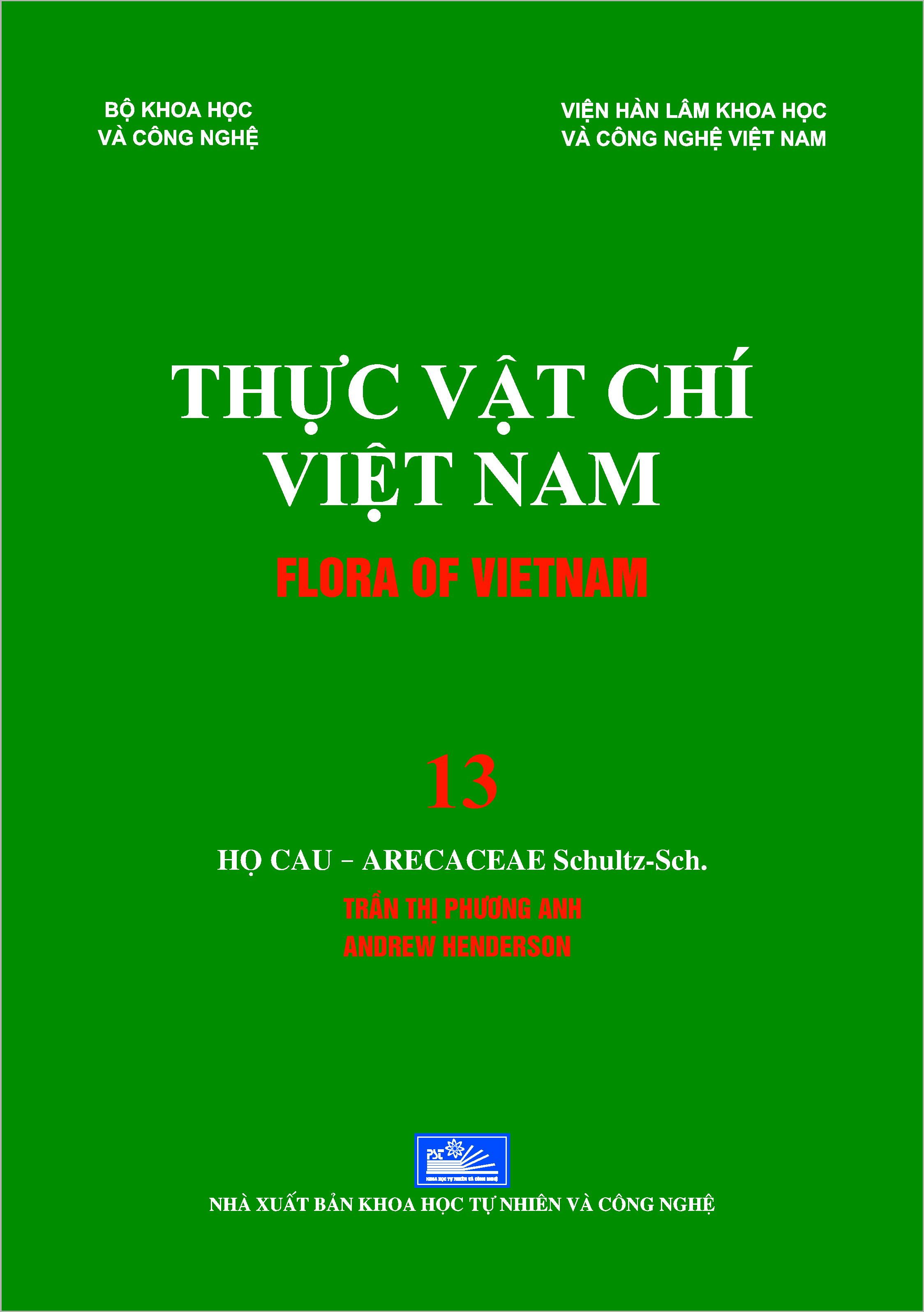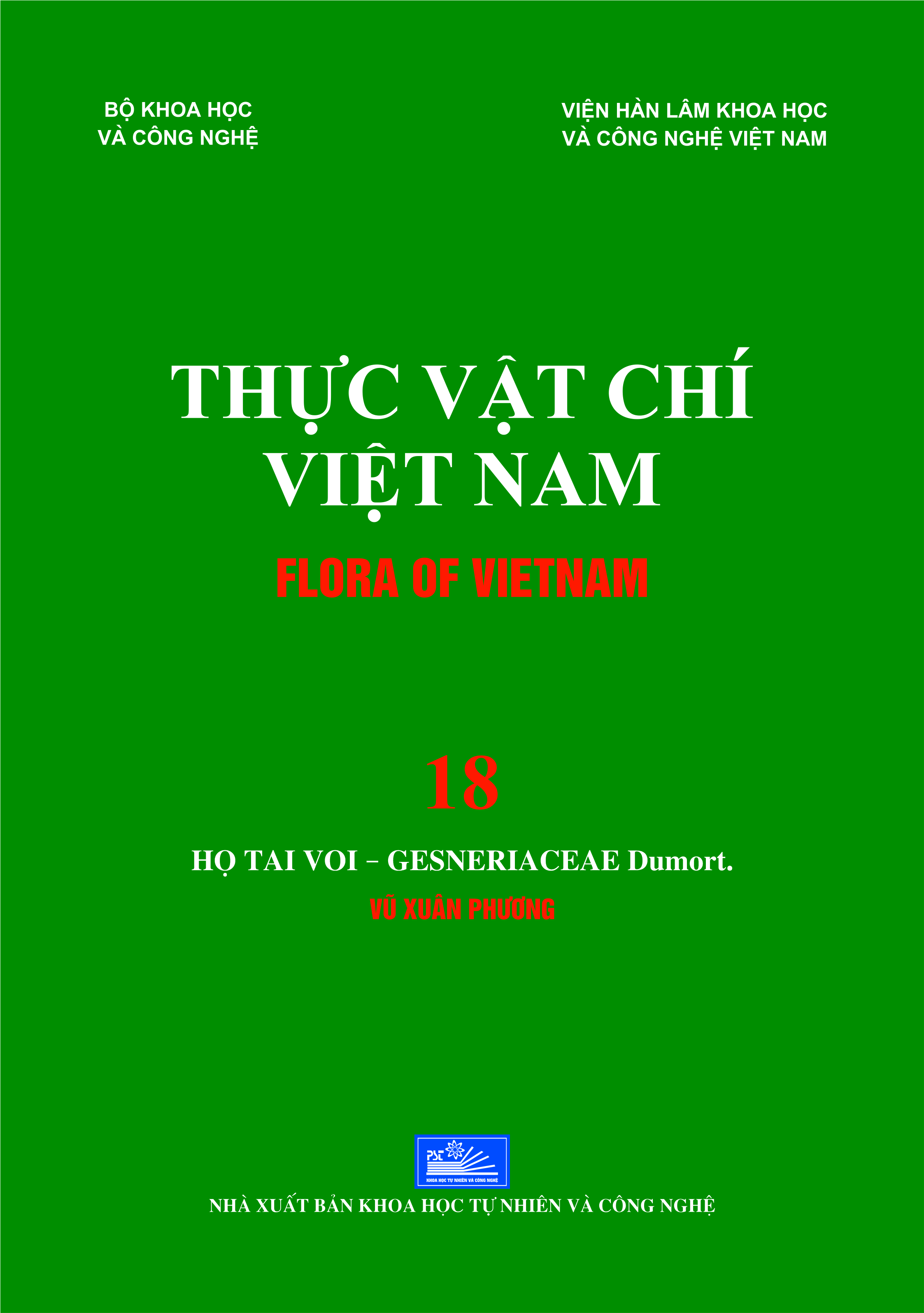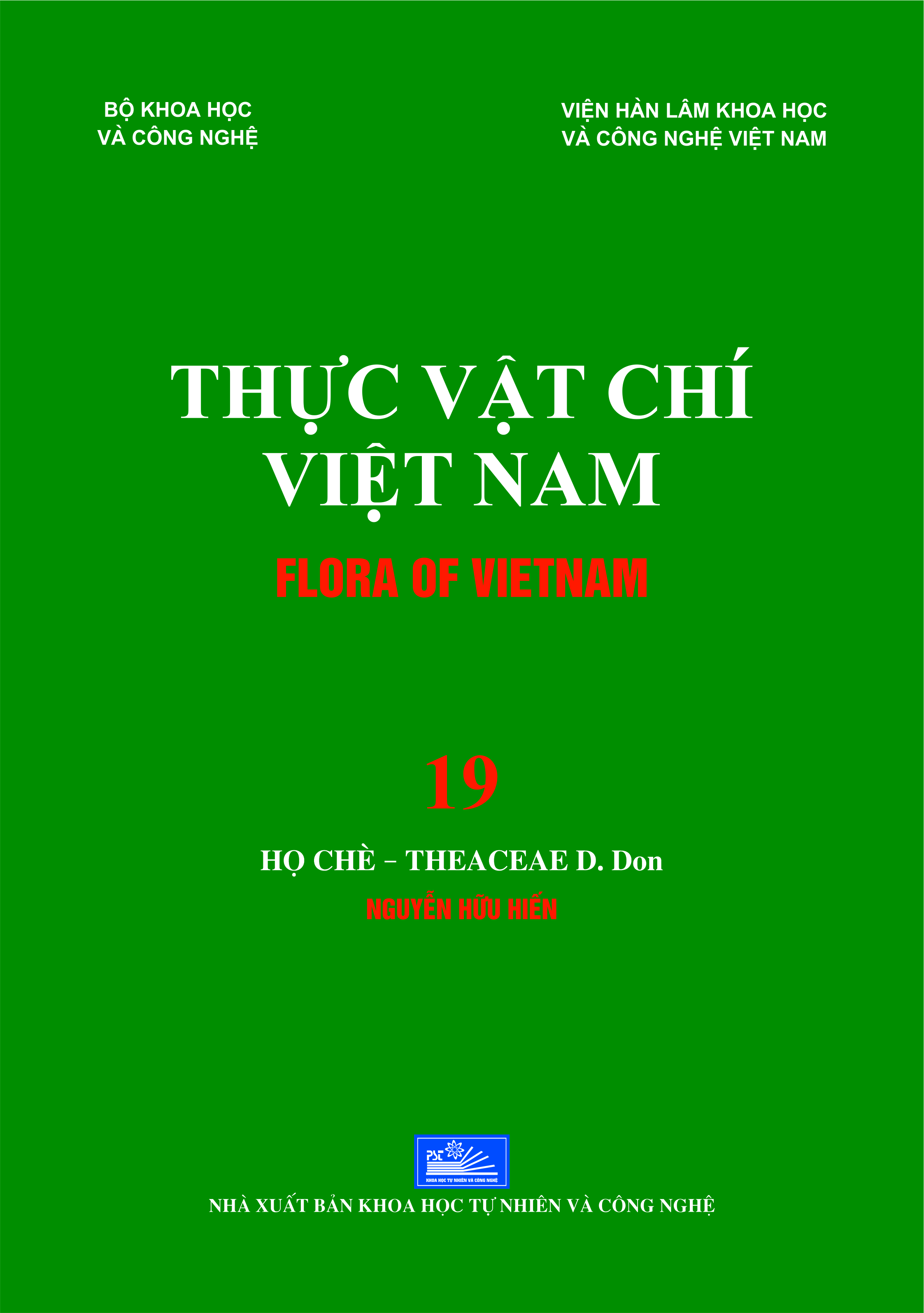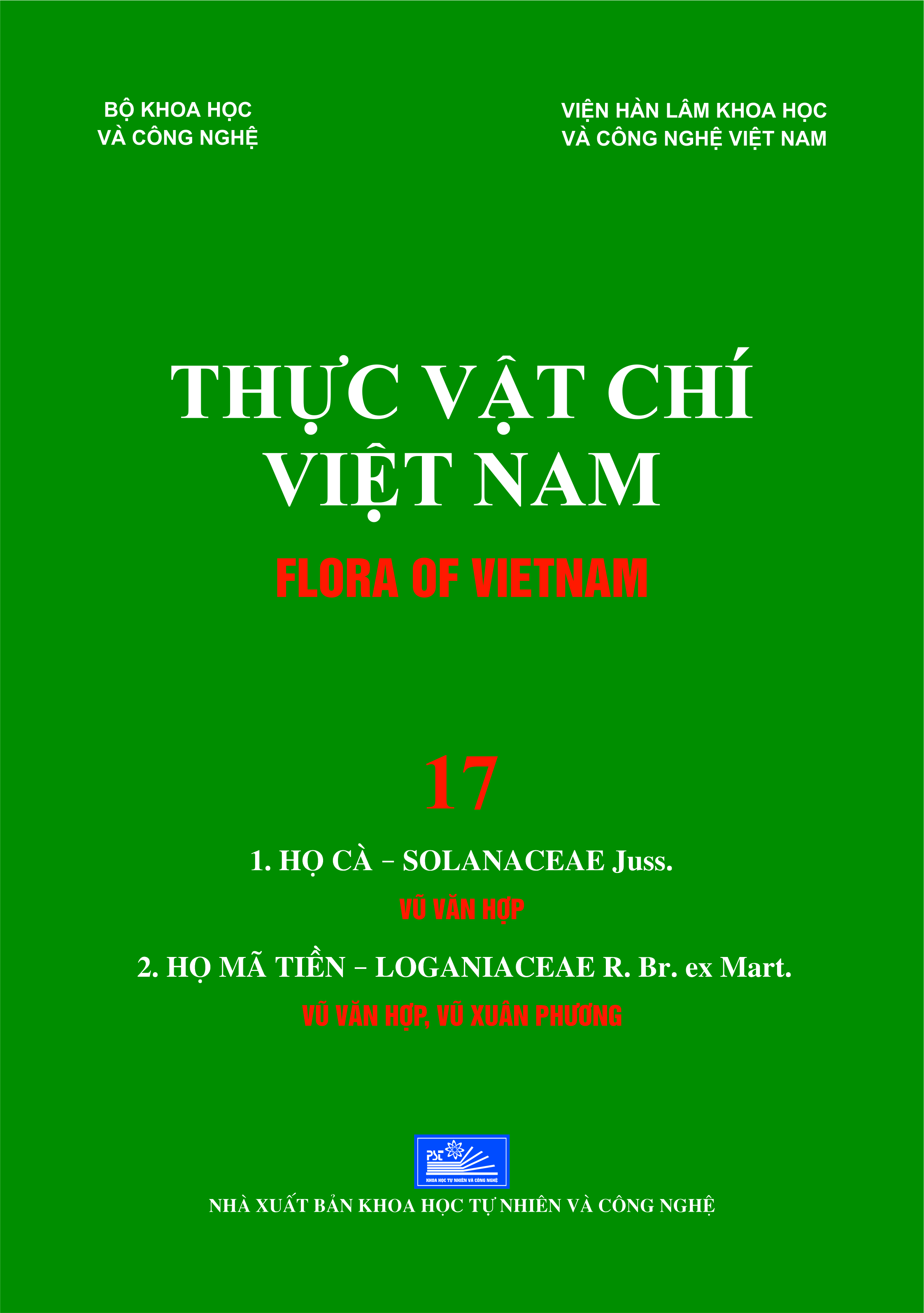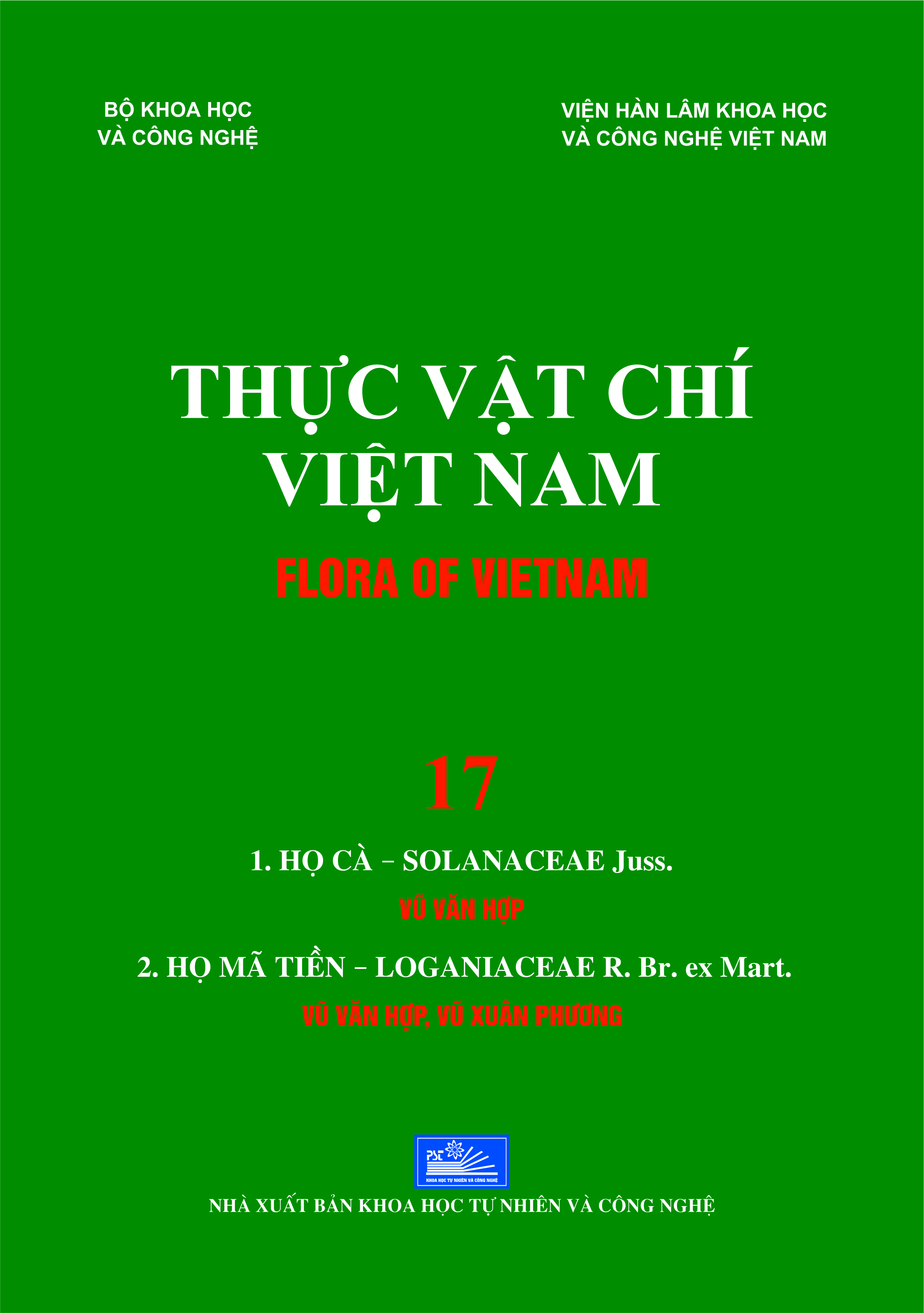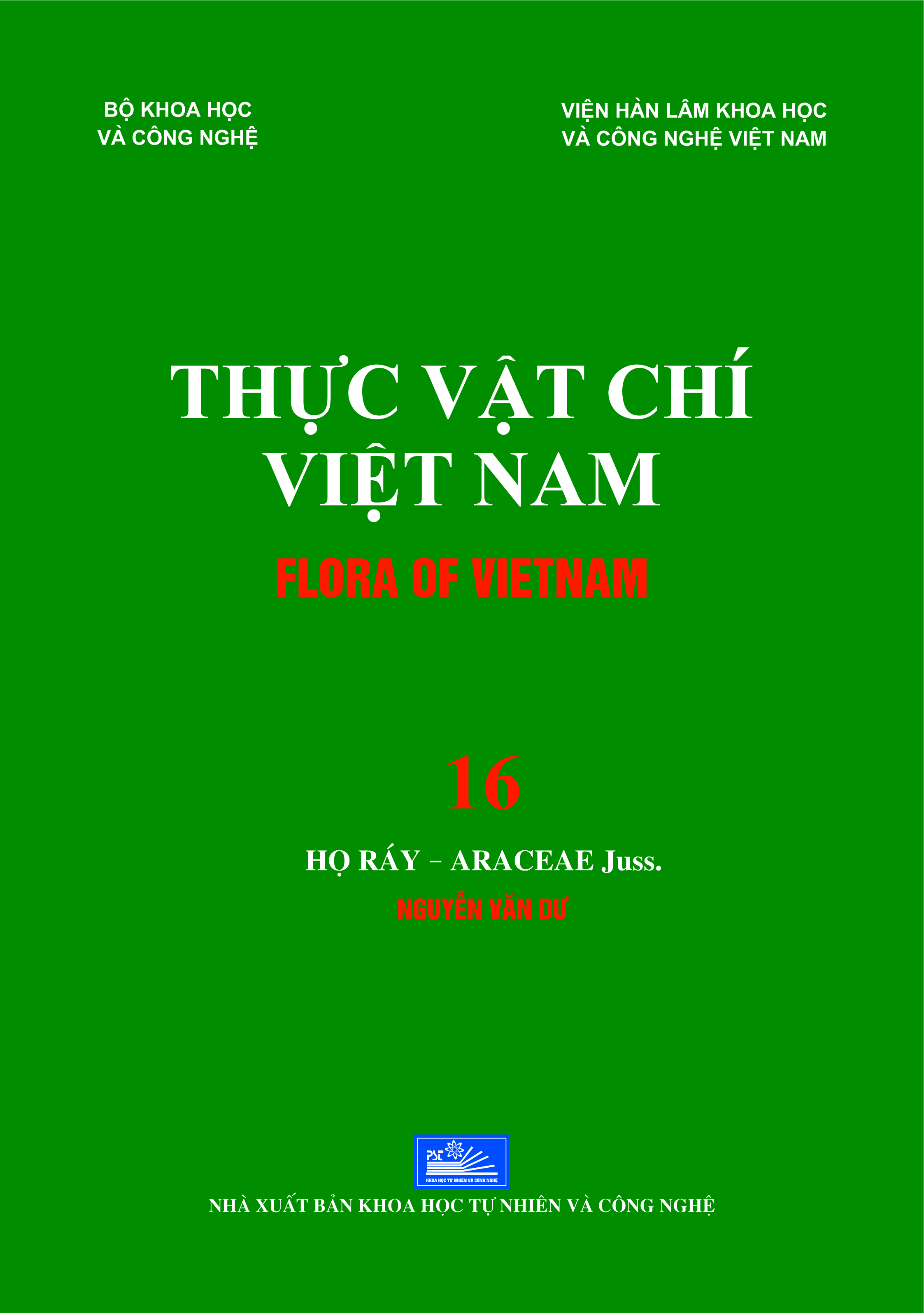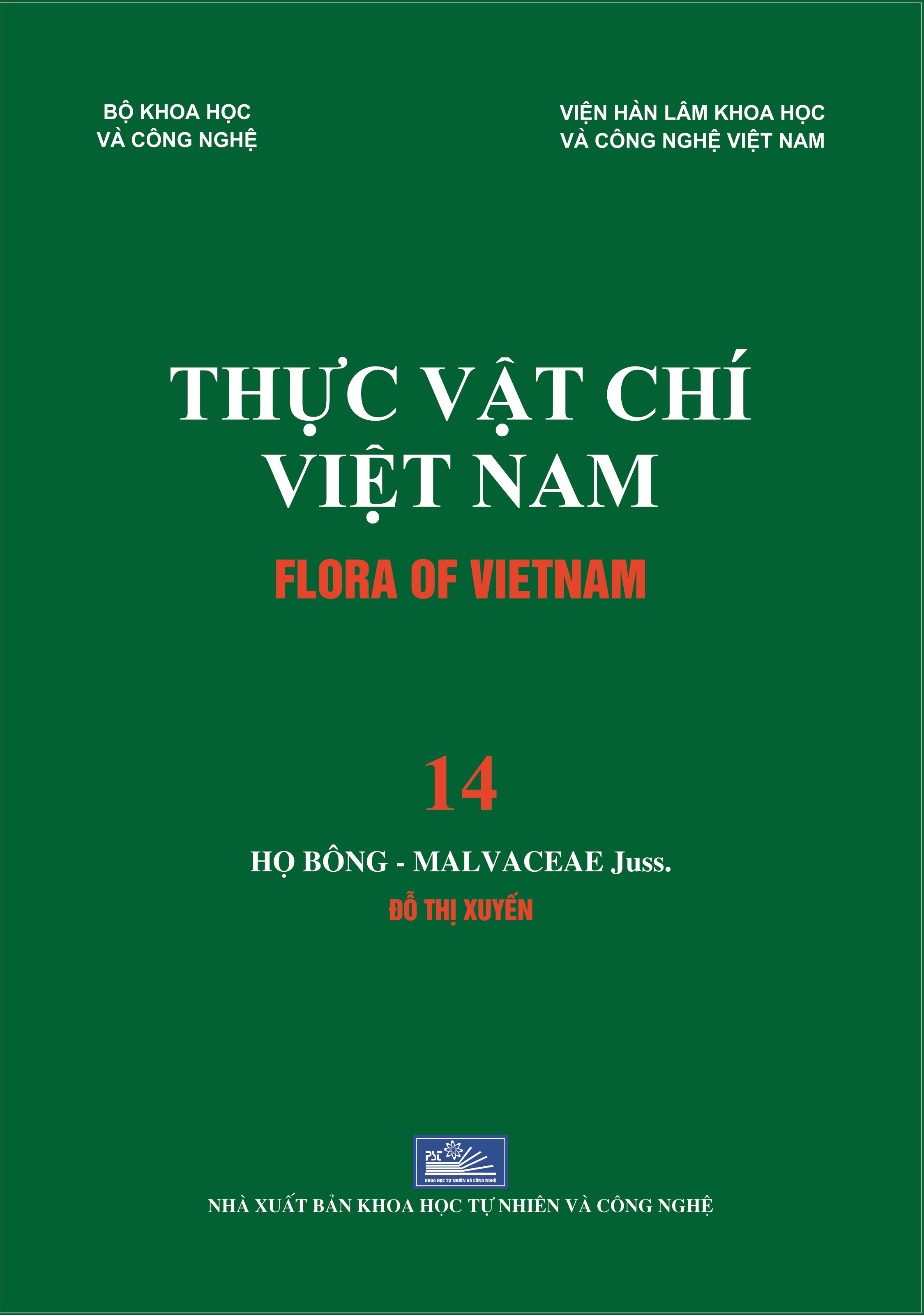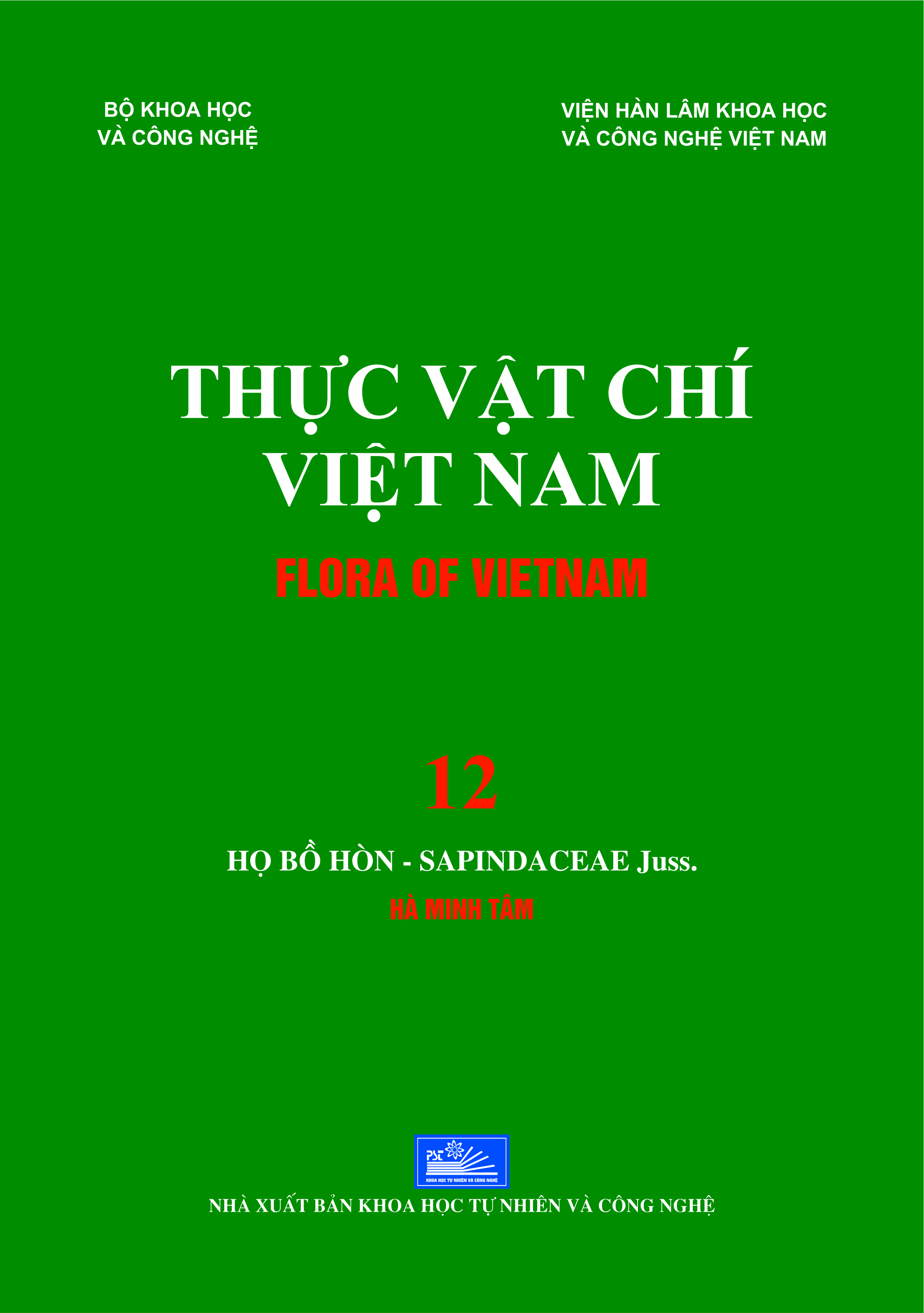ABSTRACT
FLORA OF VIETNAM 19
THEACEAE D. Don, 1822
(2 subfamilies, 5 tribes, 11 genera, 124 species, 15 varieties and 2 forma)
INTRODUCTION
The family Theaceae includes about 29 genera and 550 species, which is distributed in tropical and subtropical regions of the two hemispheres. The most basal representations are concentrated in Asia, especially in China and Indo-China. Vietnam has 11 genera, 124 species, 15 varieties and 2 forma, distributed in 40 among 63 provinces and cities, chiefly in the mountainous regions. The economic value of Theaceae is well-known, chiefly in drinking, giving tannin, some wood and drugs.
The studies about the taxonomy of Theaceae began very soon as C. Linnaeus (1753), Moech (1974), D. Don (1822), etc. After that, G. Bentham & J. D. Hooker (1862-1887), V. H. Heywood (1993), H. Melchior (1964), Phedorov (1981), A. Takhtajan (1973, 1987, 1996) etc. The revisory studies on Camellia were carried out by J. R. Sealy (1958), H. T. Chang & B. Bartholomew (1984); T. L. Ming (1999); and the genus Eurya was worked out by C. E. Kobuski (1947), L. K. Ling (1966) etc.
In Vietnam, several foreign authors also studied Theaceae such as J. Loureiro (1790), J. B. L. Pierre (1887), C. J. Pitard (1910), F. Gagnepain (1943, 1948). Besides, a lot of studies were carried out by the local taxonomists who updated the taxon status and documented several new species for the flora of Vietnam such as Le Kha Ke (1970), Pham Hoang Ho (1970, 1991, 1999), Tran Dinh Ly (1984), Nguyen Tien Ban (1997), Nguyen Tien Ban & Nguyen Huu Hien (2003), Trần Ninh (1998), Tran Ninh & N. Hakoda (1998), J. C. Rosmann (1997), etc.
In addition, there were several studies carried out related to the economic importance and uses of Theaceae members in Vietnam, such as Do Tat Loi (1986, 2000), Vo Van Chi (1997, 2012), Do Huy Bich & al. (2004), etc.
In the countries adjacent to Vietnam, studies on taxonomy of Theaceae were also carried out by several authors such as T. L. Ming (1997, 1999), H. T. Chang (1954, 1981, 1991, 1998), L. K. Ling (1996, 1998) in China; W. T. Thiselton Dyer (1874) in India; etc.
Flora of Vietnam, volume 19 on Theaceae D. Don is a full and systematic study on taxonomy. It is an output of decades of investigation, collection and research carried out in different parts of the country, especially at the places which are suitable habitat for the species of Theaceae. At the same time, authos also studied specimens and documents housed at different herbaria such as Institute of Ecology and Biological Resources (HN); Hanoi University of Science, Vietnam National University, Hanoi (HNU); Forest Inventory and Planning Institute (HNF); Institute of Tropical Biology, Ho Chi Minh City (VNM); Hanoi University of Pharmacy (HNPI), Institute of Medicinal Materials, Hanoi (HNPM); Botanical Institute Komarov, Leningrad (St. Peterburgh), USSR (LE) and Museum Natural d’Historie Naturelle, Paris, France (P).
This volume comprises of about 360 pages dealing with different systems of classification studied for Theaceae in Vietnam. It also mentions the diagnostic characters of every species of this family found in Vietnam, inventory of classification systems and keys to taxa. Accepetd Latin names for every taxon along with synonyms, morphological characters, type, ecological and biological characters, distribution inside and outside the country, specimens examined, economic value, notes (if any) are provided.
In addition, there are 117 figures of different species and 18 supporting coloured photo, keys to identification, accepted Latin and Vietnamese names, along with references. Besides, the introductory part in dealt in English (Introduction and Keys to taxon).
At the end, references, figures, coloured images from other authors are also provided.
Index to Taxa of Theaceae in Vietnam (provided as per an accepted classification systems).
I. CHECKLIST OF THE TAXA UNDER FAMILY THEACEAE IN VIETNAM
(2 subfam., 5 trib., 11 gen., 124 sp., 15 var., 2 form.)
Subfam.1. TERNSTROEMIOIDEAE Melchior (2 trib., 5 gen., 45 sp., 8 var., 1 form.)
Trib.1. TERNSTROEMIEAE (2 gen., 7 sp., 2 var.)
1. ANNESLEA Wall. (3 sp., 1 var.)
1.1. Anneslea fragrans Wall. (fig. 5)
1.1a. Anneslea fragrans Wall. var. ternstroemioides (Gagnep.) Kobuski (fig. 6)
1.2. Anneslea dongnaiensis (Gagnep.) Kobuski
1.3. Anneslea paradoxa N. H. Hien & G. P. Yakovl.
2. TERNSTROEMIA Mutis ex L. f. nom. conserv. (4 sp., 1 var.)
2.1. Ternstroemia kwangtungensis Merr. (fig. 7)
2.2a. Ternstroemia pseudoverticillata Merr. & Chun var. medionalis Gagnep. (fig. 8)
2.3. Ternstroemia chapaensis Gagnep. (fig. 9)
2.4. Ternstroemia gymnanthera (Wight & Arn.) Bedd. (fig. 10)
2.5. Ternstroemia penangiana Choisy (fig. 11)
Trib.2. ADINANDREAE Melchior (3 gen., 38 sp., 6 var., 1 form.)
3. ADINANDRA Jack. (13 sp., 3 var.)
3.1. Adinandra lienii N. H. Hien & G. P. Yakovl. (fig. 12, photo 1)
3.2. Adinandra bockiana Pritz. ex Diels (fig. 13)
3.2a. Adinandra bockiana Pritz ex Diels var. acutifolia (Hand.-Mazz.) Kobuski (fig. 14, photo 2)
3.2b. Adinandra bockiana Pritz ex Diels var. tonkinensis Kobuski
3.3. Adinandra poilanei Gagnep. (fig. 15)
3.4. Adinandra hirta Gagnep. (fig. 16)
3.5. Adinandra hainanensis Hayata (fig. 17)
3.6. Adinandra integerrima T. Anders. ex Dyer (fig. 18)
3.7. Adinandra annamensis Gagnep. (fig. 19)
3.8. Adinandra megaphylla Hu (fig. 20)
3.9. Adinandra grandifolia N. H. Hien & G. P. Yakovl.
3.10. Adinandra caudata Gagnep. (fig. 21)
3.11. Adinandra millettii (Hook. & Arn.) Benth. & Hook. f. ex Hance (fig. 22)
3.11a. Adinandra millettii (Hook. & Arn.) Benth. & Hook. f. ex Hance var. dalatensis N. H. Hien & G. P. Yakovl.
3.12. Adinandra dongnaiensis Gagnep. (fig. 23)
3.13. Adinandra microcarpa A. Chev. ex Gagnep. (fig. 24)
4. CLEYERA Thunb. (1 sp.)
4.1. Cleyera japonica Thunb. (fig. 25)
5. EURYA Thunb. (24 sp., 3 var., 1 form.)
5.1. Eurya stenophylla Merr. (fig. 26)
5.1a. Eurya stenophylla Merr. var. caudata H. T. Chang
5.2. Eurya tonkinensis Gagnep. (fig. 27)
5.3. Eurya tetragonoclada Merr. & Chun (fig. 28)
5.4. Eurya polyneura Chun (fig. 29)
5.5. Eurya persicaefolia Gagnep. (fig. 30, photo 7)
5.6. Eurya nitida Korthals (fig. 31)
5.7. Eurya japonica Thunb. (fig. 32, photo 3)
5.7a. Eurya japonica Thunb. var. harmandii Pierre ex Pitard (fig. 33)
5.8. Eurya subintegia Kobuski
5.9. Eurya muricata Dunn (fig. 34)
5.10a. Eurya cuneata Kobuski var. glabra Kubuski
5.11. Eurya chinensis R. Br. (fig. 35)
5.12. Eurya prunifolia Hsu (fig. 36)
5.13. Eurya quinquelocularis Kobuski (fig. 37)
5.14. Eurya turfosa Gagnep. (fig. 38)
5.15. Eurya groffii Merr. (fig. 39)
5.16. Eurya acuminata DC. (fig. 40)
5.17. Eurya cerasifolia (D. Don) Kobuski (fig. 41)
5.18. Eurya tsingpienensis Hu
5.19. Eurya trichocarpa Korth. (fig. 42)
5.20. Eurya ciliata Merr. (fig. 43, photo 4)
5.21. Eurya laotica Gagnep. (fig. 44)
5.22. Eurya distichophylla Hemsl. (fig. 45)
5.22a. Eurya distichophylla Hemsl. form. asymmetrica H. T. Chang
5.23. Eurya megatrichocarpa H. T. Chang (fig. 46)
5.24. Eurya henryi Hemsl. (fig. 47)
5.25. Eurya gnaphalocarpa Hayata (fig. 48)
Subfam.2. THEOIDEAE (3 trib., 6 gen., 79 sp., 7 var., 1 form.)
Trib.3. STEWARTIEAE (Airy-Shaw) H. T. Chang (1 gen., 3 sp., 1 var.)
6. HARTIA Dunn (3 sp., 1 var.)
6.1. Hartia tonkinensis Merr. (fig. 49)
6.2a. Hartia villosa (Merr.) Merr. var. kwangtungensis (Chun) H. T. Chang (fig. 50)
6.3. Hartia yunnanensis Hu (fig. 51)
Trib.4. GORDONIEAE Benth. & Hook. (2 gen., 14 sp., 1 var., 1 form.)
7. GORDONIA Eliss, nom. cons. (9 sp., 1 var., 1 form.)
7.1. Gordonia huongiana (Orel, Curry & Luu) N. H. Hien, comb. nov. (fig. 52)
7.2. Gordonia hainanensis H. T. Chang (fig. 53)
7.3. Gordonia intricata Gagnep. (fig. 54, photo 5)
7.4. Gordonia balansae Pitard (fig. 55)
7.5. Gordonia axillaris (Roxb. ex Ker-Gawl.) Dietr. (fig. 56, photo 6)
7.5a. Gordonia axillaris (Roxb. ex Ker-Gawl.) Dietr. form. subemarginata Gagnep.
7.5b. Gordonia axillaris (Roxb. ex Ker-Gawl.) Dietr. var. crenata Gagnep.
7.6. Gordonia longicarpa Chang (fig. 57)
7.7. Gordonia tonkinensis Pitard emend. Ming (fig. 58, photo 8)
7.8. Gordonia bidoupensis Gagnep. (fig. 59)
7.9. Gordonia gigantiflora Gagnep. (fig. 60)
8. SCHIMA Reinw. ex Blume (5 sp.)
8.1. Schima argentea Pritz. ex Diels (fig. 61)
8.2. Schima wallichii (DC.) Korth. (fig. 62)
8.3. Schima noronhae Reinw. ex Blume (fig. 63, photo 9)
8.4. Schima crenata Korth.
8.5. Schima khasiana Dyer (fig. 64)
Trib.5. THEEAE (3 gen., 62 sp., 5 var.)
9. CAMELLIA L. (54 sp., 3 var.)
Subgen.1. THEA (L.) H. T. Chang, emend. T. L. Ming
Sect.1. PIQUETIA (Pierre) J. R. Sealy
9.1. Camellia dongnaiensis G. Orel (fig. 65)
9.2. Camellia piquetiana (Pierre ex Lanessan) J. R. Sealy (fig. 66)
Sect.2. ARCHECAMELLIA J. R. Sealy
9.3. Camellia krempfii (Gagnep.) J. R. Sealy (fig. 67)
9.4. Camellia vidalii J. C. Rosmann (fig. 68, photo 10)
9.5. Camellia flava (Pitard) J. R. Sealy (fig. 69, photo 11)
9.6. Camellia cucphuongensis T. Ninh & Rosmann (fig. 70)
9.7. Camellia pleurocarpa (Gagnep.) J. R. Sealy (fig. 71)
9.8. Camellia aurea H. T. Chang (fig. 72)
9.9. Camellia calcicola T. L. Ming (fig. 73)
9.10. Camellia megasepala H. T. Chang & T. Ninh ex H. T. Chang
9.11. Camellia hirsuta N. Hakoda & T. Ninh (photo 12)
9.12. Camellia tonkinensis (Pitard) Cohen-Stuart (fig. 74)
9.13. Camellia sonthaiensis Luu, Luong, Q. D. Nguyen & T. Q. T. Nguyen
9.14. Camellia amplexicaulis (Pitard) Cohen-Stuart (fig. 75)
9.15. Camellia murauchii T. Ninh & N. Hakoda
9.16. Camellia impressinervis H. T. Chang & S. Y. Liang ex H. T. Chang (fig. 76)
9.17. Camellia phanii N. Hakoda & T. Ninh (photo 13)
9.18. Camellia petelotii (Merr.) J. R. Sealy (fig. 77)
9.19. Camellia thanxaensa N. Hakoda & S. Kirino (photo 14)
9.20. Camellia euphlebia Merr. ex J. R. Sealy (fig. 78)
9.21. Camellia indochinensis Merr. (fig. 79)
9.22. Camellia rubiflora T. Ninh & N. Hakoda
Sect.3. CYLINDRICEA T. L. Ming
9.23. Camellia cylindricea T. L. Ming (fig. 80)
Sect.4. THEA (L.) Dyer
9.24. Camellia sinensis (L.) O. Kuntze (fig. 81)
9.24a. Camellia sinensis (L.) O. Kuntze var. assamica (J. W. Masters) Kitamura (fig. 82, photo 16)
Sect.5. LONGIPEDICELLATA H. T. Chang
9.25. Camellia gracilipes Merr. ex J. R. Sealy (fig. 83)
Sect.6. CORALLINA J. R. Sealy
9.26. Camellia corallina (Gagnep.) J. R. Sealy (fig. 84)
9.27. Camellia nematodea (Gagnep.) J. R. Sealy (fig. 85)
9.28. Camellia nervosa (Gagnep.) H. T. Chang (fig. 86)
9.29. Camellia crassiphylla T. Ninh & N. Hakoda
9.30. Camellia gilbertii (A. Chev. ex Gagnep.) J. R. Sealy (fig. 87)
9.31. Camellia pubicosta Merr. (fig. 88)
9.32. Camellia inusitata Orel, Curry & Luu (fig. 89)
Sect.7. THEOPSIS Cohen-Stuart
9.33. Camellia glabricostata T. L. Ming (fig. 90)
9.34. Camellia forrestii (Diels) Cohen-Stuart (fig. 91)
9.35. Camellia tsaii Hu (fig. 92)
9.36. Camellia elongata (Rehd. & Wils.) Rehd. (fig. 93)
9.37. Camellia tsingpienensis Hu (fig. 94)
Sect.8. ERIANDRIA Cohen-Stuart
9.38. Camellia caudata Wall. (fig. 95)
9.39. Camellia cordifolia (Metc.) Nakai (fig. 96)
Subgen.2. CAMELLIA
Sect.9. HETEROGENEA J. R. Sealy
9.40. Camellia fleuryi (A. Chev.) J. R. Sealy (fig. 97)
9.41. Camellia gaudichaudii (Gagnep.) J. R. Sealy (fig. 98)
9.42. Camellia furfuracea (Merr.) Cohen-Stuart (fig. 99, photo 17)
Sect.10. STEREOCARPUS (Pierre) J. R. Sealy
9.43. Camellia dormoyana (Pierre ex Lanessan) J. R. Sealy (fig. 100)
Sect.11. CAMELLIA
9.44. Camellia yokdonensis Dung & N. Hakoda (photo 15)
9.45. Camellia hongkongensis Seem. (fig. 101)
9.46. Camellia japonica L. (fig. 102)
9.47a. Camellia polyodonta var. longicaudata (H. T. Chang & S. Y. Liang) T. L. Ming
(fig. 103)
Sect.12. PARACAMELLIA J. R. Sealy
9.48. Camellia oleifera Abel (fig. 104)
9.48a. Camellia oleifera Abel var. confusa (Craib) J. R. Sealy (fig. 105)
9.49. Camellia sasanqua Thunb. (fig. 106) (fig. 106)
9.50. Camellia vietnamensis Huang ex Hu (fig. 107)
9.51. Camellia kissi Wall. (fig. 108, photo 18)
Not Section:
9.52. Camellia rosmannii T. Ninh (fig. 109)
9.53. Camellia huulungensis J. C. Rosmann & T. Ninh (fig. 110)
9.54. Camellia langbianensis (Gagnep.) Phamh. (fig. 111)
10. TUTCHERIA Dunn. (2 sp., 1 var.)
10.1. Tutcheria spectabilis (Champ.) Dunn (fig. 112)
10.2a. Tutcheria hirta var. cordatula Li
10.3. Tutcheria microcarpa Dunn
11. PYRENARIA Blume (5 sp., 1 var.)
11.1. Pyrenaria jonquieriana Pierre ex Laness. (fig. 113)
11.2. Pyrenaria poilaneana Gagnep. (fig. 114)
11.3. Pyrenaria multisepala (Merr. & Chun) Keng (fig. 115)
11.4. Pyrenaria diospyricarpa Kurz (fig. 116)
11.4a. Pyrenaria diospyricarpa Kurz var. camelliaeflora (Kurz) S. X. Yang
11.5. Pyrenaria serrata Blume (fig. 117)
II. KEY TO THE GENERA OF THEACEAE IN VIETNAM
| 1A. |
Plants bissexual, unisexual or androdioecious; flowers usually small; stamens in 2 whorls; anthers basifixed. Fruit baccate or berry |
(Subfam.1. Ternstroemioideae). |
| 2A. |
Flowers larger than 1 cm in diam.; ovary-cells 1-7 ovules. Seeds longer than 3 mm |
(Trib.1. Ternstroemieae). |
| 3A. |
Flowers bissexual; ovary half inferior . |
1. ANNESLEA |
| 3B. |
Flowers unisexual, androdioecious; ovary superior. |
2.TERNSTROEMIA |
| 2B. |
Flowers less than 1 cm in diam.; ovary-cells much than 7 ovules; seeds less than 2 mm |
(Trib.2. Adinandreae). |
| 4A. |
Flowers bissexual; anthers pubescent. |
|
| 5A. |
Ovary 3-5-loculed; with many ovules per locule (more than 20); seeds less than 1 mm |
3. ADINANDRA |
| 5B. |
Ovary 2-3-loculed; ovary with several ovules (less than20) per locule; seeds 1-2 mm long. |
4. CLEYERA |
| 4B. |
Flowers monoecious or dioecious; anthers glabrous. |
5. EURYA |
| 1B. |
Plants bissexual; flowers usually large; stamens numerous, in 2-6 whorls; anthers dorsifixed; capsule or drupaceous |
(Subfam.2. Theoideae) |
| 6A. |
Seeds with a narrow wing. |
|
| 7A. |
Petiole with wing; fruit ovoid to conic; sepals persistent in fruit; columella in fruit degenerating or only extending ca. 1/2 of locule length |
(Trib.3. Stewartieae)
6. HARTIA
|
| 7B. |
Petiole wingless; fruit globose to oblate; sepals caducous or if persistent not enveloping fruit; columella in fruit extending ca. 2/3 or more locule length. |
(Trib.4. Gordonieae) |
| 8A. |
Seeds with an apical wing; fruit oblong. |
7. GORDONIA |
| 8B. |
Seeds marginally winged; capsule flattened globose. |
8. SCHIMA |
| 6B. |
Seeds wingless; globose or trigonous. |
(Trib.5. Theeae) |
| 9A. |
Capsule dehiscent from apex or from base. |
|
| 10A. |
Capsule dehiscent from apex; hilum umbilicate. |
9. CAMELLIA |
| 10B. |
Capsule dehiscent from base; hilum ovoid. |
10. TUTCHERIA |
| 9B. |
Fruit drupaceous; hilum linear or elliptic. |
11. PYRENARIA |
III. KEY TO THE SPECIES OF THEACEAE D. Don IN VIETNAM
3.1. KEY TO THE SPECIES OF ANNESLEA IN VIETNAM
| 1A. |
Pedicel longer than 20 mm. |
|
| 2A. |
Secondary veins visible. |
|
| 3A. |
Lateral veins 10-12 per side; anther-cells equal; overy not seated on a disc. |
1. A. fragrans |
| 3B. |
Lateral veins 5-6 per side; Anther-cells unequal; ovary seated on cornic disc |
2. A. dongnaiensis |
| 2B. |
Secondary veins obscure. |
1a. A. fragrans var. ternstroemioides |
| 1B. |
Petiole very short or sessile; secondary veins adaxially obscure |
3. A. paradoxa |
3.2. KEY TO THE SPECIES OF TERNSTROEMIA IN VIETNAM
| 1A. |
Venation not visible. |
|
| 2A. |
Sepals persistent at compressed-globose fruit. |
1. T. kwangtungensis |
| 2B. |
Sepals persistent at fruit globose with acute apex. |
|
| 3A. |
Stigma 3-lobed |
2a. T. pseudoverticillata var. medionalis |
| 3B. |
Stigma 4-lobed. |
3. T. chapaensis |
| 1B. |
Venation visible. |
|
| 4A. |
Secondary veins 5 on each side of midvein; stigma 3-lobed |
4. T. gymnanthera |
| 4B. |
Secondary veins 11-13 on each side of midvein, stigma 2-lobed, lobe laminar. |
5. T. penangiana |
3.3. KEY TO THE SPECIES OF ADINANDRA IN VIETNAM
| 1A. |
Ovary, fruit pubescent. |
|
| 2A. |
Style glabrous. |
|
| 3A. |
Ovary 5-loculed. |
1. A. lienii |
| 3B. |
Ovary 3-loculed. |
2. A. bockiana
A. bockiana var. bockiana
2a. A. bockiana var. acutifolia
2b. A. bockiana var. tonkinensis
|
| 2B. |
Style pubescent. |
|
| 4A. |
Branches pubescent at least when young. |
|
| 5A. |
Petals glabrous. |
|
| 6A. |
Lateral veins 14-16 per side, not anastomosing towards the margins. |
3. A. poilanei |
| 6B. |
Lateral veins 10-12 per side, anastomosing towards the margins. |
4. A. hirta |
| 5B. |
Petals pubescent. |
|
| 7A. |
Leaf blade abaxially glandular punctate. |
|
| 8A. |
Glandular punctate yellowish brown; bracteoles lanceolate, 3-4 mm long. |
5. A. hainanensis |
| 8B. |
Glandular punctate black; bracteoles suborbicular, 2 mm long |
6. A. integerrima |
| 7B. |
Leaf blade abaxially not glandular punctate. |
|
| 9A. |
Margin glandular-serrate. |
|
| 10A. |
Style longer than obvary 2-3 times, ovary globose |
7. A. annamensis |
| 10B. |
Style short, ovary conic. |
8. A. megaphylla |
| 9B. |
Margin not glandular-serrate or subentire. |
|
| 11A. |
Pedicel 1 cm long; apex acuminate. |
9. A. grandifolia |
| 11B. |
Pedicel 2.5-2.7 cm long; apex long acuminate to caudate |
10. A. caudata |
| 4B. |
Branches glabrous. |
11. A. millettii
A. millettii var. millettii
11a. A. millettii var. dalatensis
|
| 1B. |
Ovary, fruit glabrous. |
|
| 12A. |
Sepals inside puberulent. |
12. A. dongnaiensis |
| 12B. |
Sepals inside glabous. |
13. A. microcarpa |
3.4. KEY TO THE SPECIES OF CLEYERA IN VIETNAM
| Ovary 2-3-loculed; ovary with several ovules (less than 20) per locule; seeds 1-2 mm long |
C. japonica |
3.5. KEY TO THE SPECIES OF EURYA IN VIETNAM
| 1A. |
Ovary glabrous. |
|
| 2A. |
Young branches glabrous. |
|
| 3A. |
Styles 2, basally united. |
1. E. stenophylla
E. stenophylla var. stenophylla
1a. E. stenophylla var. caudata
|
| 3B. |
Styles 3. |
|
| 4A. |
Style apically 3-parted to almost distinct |
2. E. tonkinensis |
| 4B. |
Styles 3, variously connate. |
|
| 5A. |
Branches ribbed. |
|
| 6A. |
Branches 4-ribbed. |
|
| 7A. |
Leaves obolanceolate, lateral veins 8-10 per side |
3. E. tetragonoclada |
| 7B. |
Leaves oblong-lanceolate, lateral veins 20 per side. |
4. E. polyneura |
| 6B. |
Branches 2-ribbed. |
|
| 8A. |
Anthers locellate; terminal bud white pubescent |
5. E. persicaefolia |
| 8B. |
Anthers not locellate; terminal bud glabrous. |
|
| 9A. |
Sepal margins not glandular. |
|
| 10A. |
Lateral veins 9-12 per side; styles 2-3 mm long |
6. E. nitida |
| 10B. |
Lateral veins 5-7 per side; styles 1.5 mm long |
7. E. japonica
E. japonica var. japonica
|
| 9B. |
Sepal margins glandular. |
8. E. subintegia |
| 5B. |
Branches terete. |
|
| 11A. |
Leaf blade margin obtusely serrate. |
9. E. muricata |
| 11B. |
Leaf blade margin entire or subentire. |
10a. E. cuneata var. glabra |
| 2B. |
Young branches pubescent. |
|
| 12A. |
Sepals outside glabrous. |
|
| 13A. |
Young branches 2-ribbed; fruit subglobose, style apically 3-lobed. |
11. E. chinensis |
| 13B. |
Young branches terete, fruit ovoid, style apiclly 5(-3)-lobed |
12. E. prunifolia |
| 12B. |
Sepals outside pubescent. |
|
| 14A. |
Currrent year branchlets terete. |
|
| 15A. |
Ovary 5-loculed |
13. E. quinquelocularis |
| 15B. |
Ovary 3-locuked. |
|
| 16A. |
Leaf blade spathulate |
14. E. turfosa |
| 16B. |
Leaf blade lanceolate. |
|
| 17A. |
Petioles less than 3 mm long; leaf blade less than 10 cm long. |
|
| 18A. |
Petioles 1 mm long |
15. E. groffii |
| 18B. |
Petioles 2-3 mm long |
16. E. acuminata |
| 17B. |
Petole 10 mm long; leaves large, ca 20 cm long |
17. E. cerasifolia |
| 14B. |
Currrent year branchlets ribbed. |
|
| 19A. |
Leaves broadly oval |
7a. E. japonica var. harmandii |
| 19B. |
Leavea ovate |
18. E. tsingpienensis |
| 1B. |
Ovary pubescent. |
|
| 20A. |
Young branches glabrous |
19. E. trichocarpa |
| 20B. |
Young branches pubescent. |
|
| 21A. |
Branches terete. |
|
| 22A. |
Leaf blade lanceolate. |
|
| 23A. |
Currrent year branchlets densely sapreading villous. |
|
| 24A. |
Young branches black villous, persistent |
20. E. ciliata |
| 24B. |
Currrent year branchlets yellow pubescent; then glabrescent |
21. E. laotica |
| 23B. |
Currrent year branchlets pubescent. |
22. E. distichophylla
E. distichophylla var. distichophylla
22a. E. distichophylla form. asymmetrica
|
| 22B. |
Leaf blade oblong. |
|
| 25A. |
Styles 4-5-parted |
23. E. megatrichocarpa |
| 25B. |
Styles 3-parted |
24. E. henryi |
| 21B. |
Branches ribbed |
25. E. gnaphalocarpa |
3.6. KEY TO THE SPECIES OF HARTIA IN VIETNAM
| 1A. |
Fruit white; ovary pubescenst |
|
| 2A. |
Leaf blade margin entire; leaves 3-6 × 2-2.5 cm; lateral nerves 10-12 pairs |
1. H. tonkinensis |
| 2B. |
Leaf blade margin serrate; leaves 5-11.5 × 3.5-5 cm; lateral nerves 16 pairs |
2a. H. villosa var. kwangtungensis |
| 1B. |
Flower yellowish; ovary glabrous. |
3. H. yunnanensis |
3.7. KEY TO THE SPECIES OF GORDONIA IN VIETNAM
| 1A. |
Ovary 3-5-loculed. Capsule 3-5 coccals. |
|
| 2A. |
Number of locules variable in same species. |
|
| 3A. |
Lateral veins 20 pairs; flowers dark pink or red, 5-6(7) cm in diam |
1. G. huongiana |
| 3B. |
Lateral veins 7-8 pairs; flowers white, 4 cm in diam |
2. G. hainanensis |
| 2B. |
Number of locules fixed, either 3 or 5 locular. |
|
| 4A. |
Ovary 3 loculed. |
|
| 5A. |
Below sepal apex concave and revolute, the rest ones more or less spreading |
3. G. intricata |
| 5B. |
Below sepal apex neither concave and nor spreading |
4. G. balansae |
| 4B. |
Ovary 5 loculed or more than 5 loculed. |
|
| 6A. |
Young branches pubescent. |
|
| 7A. |
Leaf blade apex obtuse, rounded or emarginte; flowers terminal, pink or white-yellowish |
5. G. axillaris
G. axillaris var. axillaris
5a. G. axillaris form. subemarginata
5b. G. axillaris var. crenata
|
| 7B. |
Leaf blade apex acute; flowers axillary, white |
6. G. longicarpa |
| 6B. |
Young branches glabrous. |
|
| 8A. |
Flowers 1-2 cm in diam; leaf blade margin entire |
7. G. tonkinensis |
| 8B. |
Flowers 6-7 cm in diam; leaf blade margin obscurely crenate |
8. G. bidoupensis |
| 1B. |
Ovary 7-loculed; Capsule with 7 coccals |
9. G. gigantiflora |
3.8. KEY TO THE SPECIES OF SCHIMA IN VIETNAM
| 1A. |
Leaf blade margin entire. |
|
| 2A. |
Leaf blade abaxially silvery sericeous |
1. S. argentea |
| 2B. |
Leaf blade abaxially not silvery sericeous. |
|
| 3A. |
Young branches, petioles, sepals pubecent. Flowers large, 3-4 cm in diam |
2. S. wallichii |
| 3B. |
Young branches, petioles, sepals glabrous. Flowers small, 1.5-2 cm in diam. |
3. S. noronhae |
| 1B. |
Leaf blade margin variously crenate, serrate. |
|
| 4A. |
Leaf blade margin undulate crenate; capsule small, 1.5-2 cm in diam. |
4. S. crenata |
| 4B. |
Leaf blade margin serrate; capsule large, 3 cm in diam |
5. S. khasiana |
3.9. KEY TO THE SECTION OF CAMELLIA IN VIETNAM (According to T. L. Ming, 1999)
| 1A. |
Flowers clearly pedicellate; bracteoles at pedicel, persistent rarely caducous; sepals persistent. |
Subgen.1. Thea |
| 2A. |
Styles free. |
|
| 3A. |
Leaves large, up to 44 cm long, margin entire, slightly revolute; flowers usually 3-5 in short raceme. |
Sect.1. Piquetia |
| 3B. |
Leaves medium or small, magin serrate; flowers solitary. |
|
| 4A. |
Bracteoles (4-)5 or more; flowers usually large; gynoecium and stamens equal to petal length; outer filaments below middle connate; ovary and young fruit lobulate at the top. |
Sect.2. Archecamellia |
| 4B. |
Bracteoles 0-1-2(-3); flowers small; gynoecium, stamens shorter than a half of petal length; outer filaments usually nearly distinct; ovary and young fruit not lobulated at the top. |
Sect.6. Corallina |
| 2B. |
Style united. |
|
| 5A. |
Leaves rather large; flowers large; stamens in 3-5 whorls, basal 1/2 of outer whorl free or connate; fruit 3-5 loculed; columella persistent. |
|
| 6A. |
Bracteoles 5-6, persistent; ovary cylindrical. |
Sect.3. Cylindricea |
| 6B. |
Bracteoles 2-4, caducous or persistent; ovary globose. |
|
| 7A. |
Pedicel short or stout, less than 1 cm long; bracteoles caducous; flowers and fruits rather large; columella stout. |
Sect.4. Thea |
| 7B. |
Pedicel slender, (1.5-)2-3.5(-4.2) cm long; bracteoles caducous or persistent; flowers and fruits small; columella delicate |
Sect.5. Longipedicellata |
| 5B. |
Leaves rather small; flowers small; stamens in 2 whorls, outer filament whorl basally connate for over 2/3 of length; fruit small, only 1 locule fertile, columella abortive. |
|
| 8A. |
Petals outside glabrous; ovary and style glabrous. |
Sect.7. Theopsis |
| 8B. |
Petales outside farinose; ovary and style gfabrous pubescent. |
Sect.8. Eriandria |
| 1B. |
Flowers sessile; bracteoles contiguous with sepals; bracts, sepals halft caducous or persistent. |
Subgen.2. Camellia |
| 9A. |
Styles free. |
Sect.9. Heterogenea |
| 9B. |
Styles more or less connate. |
|
| 10A. |
Bracteoles and-sepals persistent at fruit. |
Sect.10. Stereocarpus |
| 10B. |
Bracteoles and sepals caducous after anthesis, or more or less persistent. |
|
| 11A. |
Bracteoles and sepals caducous together with-petals or more or less persistent; petals basally connate; gymnoecium, stamens as long as the pepals; basal
1/2 of outer filament whorl connate; styles apically 3-5-lobed. |
Sect.11. Camellia |
| 11B. |
Bracteoles and sepals caducous; petals free or nearly so; gymnoecium, stamens as long as half of petals; styles deeply parted or parted to base. |
Sect.12. Paracamellia |
3.9.1. KEY TO THE SPECIES CAMELLIA IN Sect.1. PIQUETIA IN VIETNAM
| 1A. |
Flowers yellow or pink; petals pentagonal shape; leaf base rounded-acute; lateral veins 22 pairs, petiole 20 mm long. |
1. C. dongnaiensis |
| 1B. |
Flowers purplish red; petals suborbiculate; leaf base rounded or cordate, lateral veins 30-40 pairs, petioles to 10 mm long. |
2. C. piquetiana |
3.9.2. KEY TO THE SPECIES CAMELLIA IN Sect.2. ARCHECAMELLIA IN VIETNAM
| 1A. |
Ovary 5-loculed. |
|
| 2A. |
Ovary pubescent. |
|
| 3A. |
Leaves large, oblong (25-40 × 6-8 cm). |
|
| 4A. |
Bracts 5-6; leaf blade base deeply cordate; inner filament whorl connate into a tube with pubescences at basal 1/2 of tube |
3(1). C. krempfii |
| 4B. |
Bracts 1-2; leaf blade base obtuse or rounded; inner flament whorl free to base and glabrous |
4(2). C. vidalii |
| 3B. |
Leaves small, leaf blade base rounded or subcordate (6-15 × 2.4-4.5 cm). |
|
| 5A. |
Sepals 5-6. |
5(3). C. flava |
| 5B. |
Sepals 8-9. |
6(4). C. cucphuongensis |
| 2B. |
Ovary glabrous. |
|
| 6A. |
Leaf blade thinly leathery, margin undulate crenate or obscurely crenate, secondary veins adaxially obscure or slightly raised, reticulate veins obscure; petioles to 5-6 mm long; pedicels 1-1.3 cm; sepals large, 1.5-2.5 cm long, outside tawny-velutinous. |
7(5). C. pleurocarpa |
| 6B. |
Leaf blade rigidly leathery, margin serrulate, secondary veins and reticulate veins adaxially clearly impressed; petioles to 7-10(-20) mm long; pedicels 5-7 mm; sepals small, 4-6 mm long, both surface glabrous |
8(6). C. aurea |
| 1B. |
Ovary 3-loculed. |
|
| 7A. |
Ovary tomentose. |
|
| 8A. |
Young branches pubescent; secondary veins more or less adaxially impressed. |
|
| 9A. |
Leaves 24-26 cm long, base cordate. |
|
| 10A. |
Leaf blade oblong, 8-8.5 cm wide; pedicels 3-4 mm; sepals 9-14 mm. |
9(7). C. calcicola |
| 10B. |
Leaf blade elliptic, 11 cm wide ; pedicels 6-8 mm; sepals 20-30 mm. |
10(8). C. megasepala |
| 9B. |
Leaves 18-20 cm long, base rounded. |
11(9). C. hirsuta |
| 8B. |
Young branches glabrous; secondary veins raised on both surfaces. |
|
| 11A. |
Ovary usually 3-loculed; petals 10-12; leaf blade elliptic . |
12(10). C. tonkinensis |
| 11B. |
Ovary 3-loculed but also 4-loculed; petals 7; leaf blade narrowly lanceolate. |
13(11). C. sonthaiensis |
| 7B. |
Ovary glabrous. |
|
| 12A. |
Leaf blade thickly leathery, base cordate and auriculate and amplexicaul. |
|
| 13A. |
Ovary seated on a conic receptacle; leaf blade 12-22 cm long, secondary veins 11-13 pairs |
14(12). C. amplexicaulis |
| 13B. |
Ovary not seated on a conic receptacle; leaf blade 27.3-33.5 cm long, secondary veins 17-20 pairs |
15(13). C. murauchii |
| 12B. |
Leaf blade leathery or thinly leathery, base cuneate to rounded. |
|
| 14A. |
Flowers yellow or yellowish or white, filaments glabrous. |
|
| 15A. |
Accessory buds large, long terete; young branches, leaf blade abaxially, petioles pubescent, leaf blade midvein and secondary veins adaxially clearly impressed |
16(14). C. impressinervis |
| 15B. |
Accessory buds small, ovoid; young branches, leaf blade abaxially, petioles glabrous; leaf blade midvein and secondary veins adaxially more or less impressed or not. |
|
| 16A. |
Bracteoles 7-10; flowers large (3.5-) 4-6 cm in diam; petals golden yellow; fruit large, 4-6 cm in diam. |
|
| 17A. |
Leaf blade oblong-elliptic or oblong. |
|
| 18A. |
Pedicels 10-15 mm. |
|
| 19A. |
Petals 16-18; stamens 400. |
17(15). C. phanii |
| 19B. |
Petals 8-14; stamens ca. 200. |
18(16). C. petelotii |
| 18B. |
Pedicels 7-8 mm. |
19(17). C. thanxaensa |
| 17B. |
Leaf blade elliptic; pedicels 4-5 mm |
20(18). C. euphlebia |
| 16B. |
Bracteoles 5(-6); flowers mediun-sized or rather small, white; fruit small, less than 4 cm in diam. |
21(19). C. indochinensis |
| 14B. |
Flowers red; filaments pubescent at basal. |
22(20). C. rubiflora |
3.9.3. KEY TO THE SPECIES CAMELLIA IN Sect.3. CYLINDRICEA IN VIETNAM
| Bracteoles 5-6, persistent; ovary cylindrical |
23(1). C. cylindricea |
3.9.4. KEY TO THE SPECIES CAMELLIA IN Sect.4. THEA IN VIETNAM
| 1A. |
Pedicels 6-10 mm long; sepals more or less pubescent on both surfaces |
24(1). C. sinensis
C. sinensis var. sinensis
|
| 1B. |
Pedicels 3-6 mm long; sepals inside glabrous. |
24a(1). C. sinensis var. assamica |
3.9.5. KEY TO THE SPECIES CAMELLIA IN Sect.5. LONGIPEDICELLATA IN VIETNAM
| Pedicels slender; bracteoles persistent or caducous; flowers and fruits small; columella delicate |
25(1). C. gracilipes |
3.9.6. KEY TO THE SPECIES CAMELLIA IN Sect.6. CORALLINA IN VIETNAM
| 1A. |
Bracteole none or only 1 on pedicel. |
|
| 2A. |
Leaf blade oblong-lanceolate, 6.5-11 cm long, apex acuminate; pedicels 6-7 mm long, without bracteoles on pedicel; ovary tomentose. |
26(1). C. corallina |
| 2B. |
Leaf blade elliptic, 4.5-6.5 cm long, apex obtuse; pedicels 2-3 mm long, bracteole 1; ovary glabrous. |
27(2). C. nematodea |
| 1B. |
Bracteoles 2-3 on pedicel. |
|
| 3A. |
Ovary glabrous. |
|
| 4A. |
Young branches, leaves, petioles glabrous. |
|
| 5A. |
Lateral veins 5-7 pairs, leaf base cuneate; flowers very small-sized |
28(3). C. nervosa |
| 5B. |
Lateral veins 8-9 pairs, leaf base rounded or cordate; flowers large 4-4.3 cm in diam |
29(4). C. crassiphylla |
| 4B. |
Young branches, leaves, petioles slightly pubescent |
30(5). C. gilbertii |
| 3B. |
Ovary villous |
|
| 6A. |
Leaf base obtuse-rounded; fruits globose, 1-loculed with 1 seed |
31(6). C. pubicosta |
| 6B. |
Leaf base cordate, sha,llowly amplexicaul; fruits compressed globose, 3-loculed with 6-seed. |
32(7). C. inusitata |
3.9.7. KEY TO THE SPECIES CAMELLIA IN Sect.7. THEOPSIS IN VIETNAM
| 1A. |
Young branches glabrous |
33(1). C. glabricostata |
| 1B. |
Young branches pubescent. |
|
| 2A. |
Filaments glabrous. |
|
| 3A. |
Style divised to middle; sepals outside glabrous. |
34(2). C. forrestii |
| 3B. |
Style only divised apically; sepals pubescent on both surfaces. |
35(3). C. tsaii |
| 2B. |
Filaments pubescent in free part. |
|
| 4A. |
Pedicels 7-10 mm; calyx ca. 2/3 connate into a hight cup. |
36(4). C. elongata |
| 4B. |
Pedicels ca. 2 mm; calyx nearly free. |
37(5). C. tsingpienensis
|
3.9.8. KEY TO THE SPECIES CAMELLIA IN Sect.8. ERIANDRIA IN VIETNAM
| 1A. |
Leaf blade base rounded; young branches pubescent; sepal apex rounded |
38(1). C. caudata |
| 1B. |
Leaf blade base cordate; young branches villous; sepal apex acute. |
39(2). C. cordifolia |
3.9.9. KEY TO THE SPECIES CAMELLIA IN Sect.9. HETEROGENEA IN VIETNAM
| 1A. |
Leaf blade abaxially not glandular; ovary glabrous. |
40(1). C. fleuryi |
| 1B. |
Leaf blade abaxially clearly glandular punctate; ovary tomentose. |
|
| 2A. |
Apex obtuse-rounded. |
41(2). C. gaudichaudii |
| 2B. |
Apex acute |
42(3). C. furfuracea |
3.9.10. KEY TO THE SPECIES CAMELLIA IN Sect.10. STEREOCARPUS IN VIETNAM
| Styles more or less connate; bracteoles and sepals persistent at fruit |
43(1). C. dormoyana |
3.9.11. KEY TO THE SPECIES CAMELLIA IN Sect.11. CAMELLIA IN VIETNAM
| 1A. |
Bracts and sepals (perules) 6-8 |
44(1). C. yokdonensis |
| 1B. |
Bracts and sepals (perules) 9-10. |
|
| 2A. |
Ovary tomentose. |
45(2). C. hongkongensis |
| 2B. |
Ovary glabrous. |
|
| 3A. |
Bracts and sepals more or less persistent. |
46(3). C. japonica |
| 3B. |
Bracts and sepals together petals decidous after anthesis |
47a(4a). C. polyodonta var. longicaudata |
3.9.12. KEY TO THE SPECIES CAMELLIA IN Sect.12. PARACAMELLIA IN VIETNAM
| 1A. |
Style glabrous or basally pubescent. |
|
| 2A. |
Capsule 1.7-2.2 cm large; filaments white. |
|
| 3A. |
Style 9-10 mm; leaves obovate; stigmas 3 speading |
48(1). C. oleifera
C. oleifera var. oleifera
|
| 3B. |
Style 4-6 mm; leaves oblanceolate or elliptic; stigmas 3 slightly slanding |
48a(1a). C. oleifera var. confusa |
| 2B. |
Capsule 1.5-1.8 cm large; filaments yellow |
49(4). C. sasanqua |
| 1B. |
Style variously villose. |
|
| 4A. |
Style sparsely pilose; flowers large, 7-11 cm in diam; pericarp 6-9 mm thick |
50(2). C. vietnamensis |
| 4B. |
Style villose; flowers smaller, 2-3 cm in diam; pericarp 1.5 mm thick. |
51(3). C. kissi |
3.9.13. KEY TO THE SPECIES CAMELLIA IN Sect. NOT ARRANGED YET IN VIETNAM
| 1A. |
Ovary 3-loculed, styles 3, free to base; leaves glabous when young. |
|
| 2A. |
Bracts and sepals pubescent. |
52(1). C. rosmannii |
| 2B. |
Bracts and sepals glabrous. |
53(2). C. huulungensis |
| 1B. |
Ovary 5-loculed, styles 5, connate; leaves velutinous when young. |
54(3). C. langbianensis |
3.10. KEY TO THE SPECIES OF TUTCHERIA IN VIETNAM
| 1A. |
Ovary 5-6-locular. |
1. T. spectabilis |
| 1B. |
Ovary 3-locular. |
|
| 2A. |
Leaf blade base rounded or cordate. |
2a. T. hirta var. cordatula |
| 2B. |
Leaf blade base cuneate. |
3. T. microcarpa |
3.11. KEY TO THE SPECIES OF PYRENARIA IN VIETNAM
| 1A. |
Drupe oblong with three obtuse angles. |
1. P. jonquieriana |
| 1B. |
Drupe globose or ovoid. |
|
| 2A. |
Ovary 3-loculed; fruit globose. |
|
| 3A. |
Flowers white. |
2. P. poilaneana |
| 3B. |
Flowers yellow. |
3. P. multisepala |
| 2B. |
Ovary 5-loculed, apically 5-6-lobed, globose or obovoid. |
|
| 4A. |
Leaves with intermediate veins; margin sparsely undulate-serrulate or obscurely crenate. |
4. P. diospyricarpa
P. diospyricarpa var. diospyricarpa
4a. P. diospyricarpa var. camelliaeflora
|
| 4B. |
Leaves not intermediate veins, margin serulate. |
5. P. serrata |
